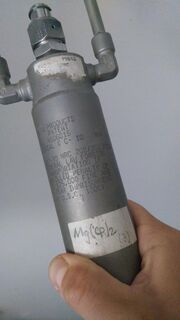Chemistry:Magnesocene

| |
| Names | |
|---|---|
| IUPAC name
bis(η5-cyclopentadienyl)magnesium
| |
| Identifiers | |
3D model (JSmol)
|
|
| ChemSpider |
|
| EC Number |
|
PubChem CID
|
|
| |
| |
| Properties | |
| C10H10Mg | |
| Molar mass | 154.495 g·mol−1 |
| Melting point | 176 °C (349 °F; 449 K) |
| Hazards | |
| Safety data sheet | External SDS |
| GHS pictograms |   
|
| GHS Signal word | Danger |
| H228, H250, H261, H314 | |
| P210, P231+232, P280, P303+361+353, P304+340+310, P305+351+338+310, P335+334, P422 | |
Except where otherwise noted, data are given for materials in their standard state (at 25 °C [77 °F], 100 kPa). | |
| Infobox references | |
Magnesocene, also known as bis(cyclopentadienyl)magnesium(II) and sometimes abbreviated as MgCp2, is an organometallic compound with the formula Mg(η5-C5H5)2. It is an example of an s-block main group sandwich compound, structurally related to the d-block element metallocenes, and consists of a central magnesium atom sandwiched between two cyclopentadienyl rings.
Properties
Magnesocene is a white solid at room temperature.[1] It has a melting point of 176 °C, though at atmospheric pressures it sublimes at 100 °C.[1] Unlike ferrocene, magnesocene displays slight dissociation and subsequent ion association in polar, electron-donating solvents (such as ether and THF).[2]
- [math]\ce{ MgCp2 <=> MgCp+ + Cp- }[/math]
- [math]\ce{ MgCp2 + MgCp+ <=> Mg2Cp3+ }[/math]
- [math]\ce{ MgCp2 + Cp- <=> MgCp3- }[/math]
While ferrocene is stable at ambient conditions, magnesocene decomposes rapidly on exposure to oxygen or moisture, and as such must be synthesized and stored under inert conditions.[3]
Structure and bonding
As revealed by X-ray crystallographic refinement, solid-phase magnesocene exhibits an average Mg-C and C-C bond distance of 2.30 Å and 1.39 Å, respectively, and the Cp rings adopt a staggered conformation (point group D5d).[4] Gas-phase electron diffraction has shown similar bond lengths, albeit with the Cp rings in an eclipsed conformation (point group D5h).[5][6]
The nature of Mg-Cp bonding has been hotly contested as to whether the interaction is primarily ionic[7][8] or covalent[5][6][9] in character. Gas-phase electron diffraction measurements have been invoked to argue for a covalent model, while vibrational spectroscopy measurements have offered evidence for both.
Hartree-Fock calculations have shown that, in contrast to transition metal metallocenes, the Mg 3d orbitals play no role in metal-ring bonding; instead, favorable bonding interactions with the Cp π system are accomplished by promotion of the two 3s electrons to the 3px,y orbitals.[10] Further stabilization is afforded by back-donation from the Cp rings to the Mg 3s orbital. Such interactions afford a lesser degree of orbital overlap as compared to ferrocene, resulting in a comparatively weak metal-ring bond and a fairly high effective local charge on Mg. Experimental evidence in favor of an ionic bonding model can thus be explained by the very weak, highly polar Mg-Cp interactions. The weak nature of this bonding mode is responsible for magnesocene's relative instability and vigorous reactivity when compared to ferrocene.
Synthesis
High-temperature synthesis
The first synthesis of magnesocene, as reported by F. A. Cotton and Geoffrey Wilkinson in 1954, involved the thermal decomposition of the cyclopentadienyl Grignard reagent.[11] A similar procedure was offered by W. A. Barber in which cyclopentadiene is directly reacted with solid magnesium at 500-600 °C.[1] Under water- and oxygen-free conditions, freshly distilled monomeric cyclopentadiene is directed through a tube furnace by an inert carrier gas (such as helium, argon, or nitrogen) and passed over magnesium turnings or powder. Magnesocene deposits on cooler surfaces past the exit end of the furnace. The product of this process is typically a white, fluffy mass of fine microcrystals, but large, colorless single crystals can be obtained by adjusting temperature and flow rate. If solid magnesocene is not needed, the receiving flask can instead be filled with solvent and the product collected in solution, which Barber noted as much safer to handle than the pure solid.
- [math]\ce{ Mg + 2C5H6 ->[500-600 ^oC] Mg(C5H5)2 + H2 }[/math]
This procedure is capable of producing a gram of product every two minutes under ideal conditions, and that with a vertical setup (in which cyclopentadiene is directed downwards and the product collected below) nearly pure product can be obtained at >80% yield (by cyclopentadiene). A horizontal setup was shown to be possible but at the expense of product purity, due to gas flow restriction by product accumulation.
Liquid-phase methods
Magnesocene can be produced from magnesium turnings in THF at mild conditions with cyclopentadienyltitanium trichloride (CpTiCl3) acting as a catalyst.[12] Maslennikov et al. later showed similar catalytic activity with Cp2TiCl2, TiCl3, TiCl4, and VCl3.[13] The mechanism, as shown by electron spin resonance, proceeds through a Cp2TiH2MgCl intermediate.[13] Magnesocene formation from elemental magnesium has not been observed in THF without a catalyst present.[13] Attempts to substitute THF with diethyl ether, diglyme, or benzene resulted only in polymerization of cyclopentadiene.[13]
The syntheses of magnesocene and its derivatives have also been carried out in hydrocarbon solvents, such as heptane, from Cp and (nBu)(sBu)Mg.[14][15]
Metallation of cyclopentadiene can also be accomplished by Mg-Al alkyl complexes with a final magnesocene yield of 85%.[14]
Reactivity and potential applications
Magnesocene serves as an intermediate in the preparation of transition metal metallocenes:[16]
- [math]\ce{ MgCp2 + MCl2 -> MCp2 + MgCl2 }[/math]
Magnesocene also undergoes ligand exchange reactions with MgX2 (X = halide) to form CpMgX half-sandwich compounds in THF:[17]
- [math]\ce{ MgCp2 + MgX2 <=> 2 CpMgX }[/math]
The resulting half-sandwich halides can serve as starting materials for synthesizing substituted cyclopentadienes from organic halides.[14]
Because of its high reactivity, magnesocene is an attractive target for semiconductor research as a starting material for chemical vapor deposition and doping applications.[18][19]
Magnesocene has also been investigated for its potential use as an electrolyte in next-generation magnesium ion batteries.[2]
References
- ↑ 1.0 1.1 1.2 Barber, W. A.; Jolly, William L. (1960), "Magnesium Cyclopentadienide", Inorganic Syntheses (John Wiley & Sons, Ltd): pp. 11–15, doi:10.1002/9780470132371.ch5, ISBN 9780470132371
- ↑ 2.0 2.1 Schwarz, Rainer; Pejic, Marijana; Fischer, Philipp; Marinaro, Mario; Jörissen, Ludwig; Wachtler, Mario (2016-11-21). "Magnesocene-Based Electrolytes: A New Class of Electrolytes for Magnesium Batteries". Angewandte Chemie International Edition 55 (48): 14958–14962. doi:10.1002/anie.201606448. ISSN 1521-3773. PMID 27791301.
- ↑ Barber, W. A. (1957-01-01). "A new preparation of magnesium cyclopentadienide". Journal of Inorganic and Nuclear Chemistry 4 (5–6): 373–374. doi:10.1016/0022-1902(57)80026-8. ISSN 0022-1902.
- ↑ Bünder, W.; Weiss, E. (1975-06-10). "Verfeinerung der kristallstruktur von dicyclopentadienylmagnesium, (η-C5H5)2Mg [Refinement of the crystal structure of dicyclopentadienylmagnesium, (η5-C5H5)2Mg]". Journal of Organometallic Chemistry 92 (1): 1–6. doi:10.1016/S0022-328X(00)91094-5. ISSN 0022-328X.
- ↑ 5.0 5.1 Starowieyski, Kazimir B.; Brunvoll, Jon; Novak, David P.; Lusztyk, Janusz; Haaland, Arne (1974-01-01). "Molecular structures of dicyclopentadienylmagnesium and dicyclopentadienylchromium by gas-phase electron diffraction". Journal of the Chemical Society, Chemical Communications (2): 54–55. doi:10.1039/C39740000054. ISSN 0022-4936.
- ↑ 6.0 6.1 Haaland, A.; Lusztyk, J.; Brunvoll, J.; Starowieyski, K. B. (1975-02-11). "On the molecular structure of dicyclopentadienylmagnesium". Journal of Organometallic Chemistry 85 (3): 279–285. doi:10.1016/S0022-328X(00)80301-0. ISSN 0022-328X.
- ↑ Cotton, F. A.; Reynolds, L. T. (January 1958). "The Structure and Bonding of Cyclopentadienylthallium and Bis-cyclopentadienylmagnesium". Journal of the American Chemical Society 80 (2): 269–273. doi:10.1021/ja01535a004. ISSN 0002-7863.
- ↑ Aleksanyan, V. T.; Garbuzova, I. A.; Gavrilenko, V. V.; Zakharkin, L. I. (1977-04-12). "Vibrational spectra and structure of bis(cyclopentadienyl)magnesium". Journal of Organometallic Chemistry 129 (2): 139–143. doi:10.1016/S0022-328X(00)92483-5. ISSN 0022-328X.
- ↑ Lippincott, Ellis R.; Xavier, J.; Steele, D. (1961-05-01). "The Vibrational Spectra and Structure of Bis-cyclopentadienylmagnesium". Journal of the American Chemical Society 83 (10): 2262–2266. doi:10.1021/ja01471a011. ISSN 0002-7863.
- ↑ Faegri Jr., K.; Almlöf, J.; Lüth, H. P. (1983-06-28). "The geometry and bonding of magnesocene. An AB-initio MO-LCAO investigation". Journal of Organometallic Chemistry 249 (2): 303–313. doi:10.1016/S0022-328X(00)99429-4. ISSN 0022-328X.
- ↑ Wilkinson, G.; Cotton, F. A. (1954). Chemistry & Industry (London). 11: 307.
- ↑ Saito, Taro (1971-01-01). "Preparation of biscyclopentadienylmagnesium by means of a titanium complex catalyst". Journal of the Chemical Society D: Chemical Communications (22): 1422. doi:10.1039/C29710001422. ISSN 0577-6171.
- ↑ 13.0 13.1 13.2 13.3 Maslennikov, Stanislav V.; Ignatyev, Roman A.; Piskounov, Alexandr V.; Spirina, Irina V. (2001-03-01). "Synthesis of magnesium dicyclopentadienide catalyzed by titanium and vanadium derivatives". Applied Organometallic Chemistry 15 (3): 161–168. doi:10.1002/aoc.115. ISSN 1099-0739.
- ↑ 14.0 14.1 14.2 Dzhemilev, U. M.; Ibragimov, A. G.; Tolstikov, G. A. (1991-03-26). "Synthesis and transformations of "non-grignard" organomagnesium reagents obtained from 1,3-dienes". Journal of Organometallic Chemistry 406 (1–2): 1–47. doi:10.1016/0022-328X(91)83169-5. ISSN 0022-328X.
- ↑ Eisch, J. J.; Sanchez, R. (1985-12-03). "Facile magnesiation of carbon brønsted acids with electrophilic, donor-free alkylmagnesium compounds". Journal of Organometallic Chemistry 296 (3): c27–c31. doi:10.1016/0022-328X(85)80378-8. ISSN 0022-328X.
- ↑ Hull, H. S.; Reid, Allen Forrest; Turnbull, Alan G. (1967-04-01). "Heat of formation and bond energy of bis(cyclopentadienyl)magnesium". Inorganic Chemistry 6 (4): 805–807. doi:10.1021/ic50050a032. ISSN 0020-1669.
- ↑ Ford, Warren T.; Grutzner, John B. (1972-08-01). "Proton and carbon-13 nuclear magnetic resonance spectra of cyclopentadienylmagnesium compounds in tetrahydrofuran". The Journal of Organic Chemistry 37 (16): 2561–2564. doi:10.1021/jo00981a009. ISSN 0022-3263.
- ↑ Lundberg, Å; Andersson, S. G.; Landgren, G.; Rask, M. (1988-07-01). "Abruptp- type doping transitions using bis-(cyclopentadienyl)-magnesium in metal-organic vapor phase epitaxy of GaAs". Journal of Electronic Materials 17 (4): 311–314. doi:10.1007/BF02652111. ISSN 1543-186X. Bibcode: 1988JEMat..17..311R.
- ↑ Kondo, M.; Anayama, C.; Sekiguchi, H.; Tanahashi, T. (1994-08-01). "Mg-doping transients during metalorgic vapor phase epitaxy of GaAs and AlGaInP". Journal of Crystal Growth 141 (1–2): 1–10. doi:10.1016/0022-0248(94)90085-X. ISSN 0022-0248. Bibcode: 1994JCrGr.141....1K.
 |





